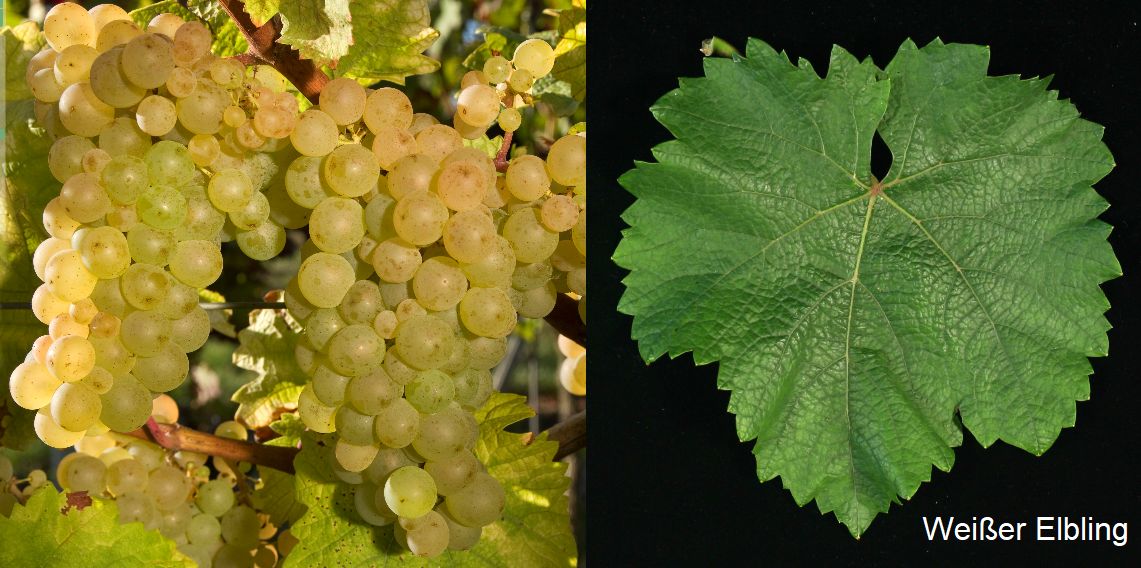The white grape variety originates from Germany. Around 125 synonyms attest to its great age and once wide distribution. Important ones are Aelbinen, Albich, Albig, Alben, Albich, Alva, Burgegger, Elbinger, Frankenthaler, Grausilber, Grobburger, Grobe from Austria, Grobriesling, Großriesling, Grüner Heunisch, Grünsilber, Kleinbeer, Kleinberger, Kleinburger, Rheinalben, Schuldenzahler, Silberweiß, Weißer Elbling, Weißer Silvaner, Weißstock (Germany); Burger, Burgauer, Elbling Blanc, Rheinelbe (Alsace); Allemand, Allemand Blanc, Allemand Facun, Alsacien, Facon Blanc, Facum d'Allemagne, Gonais Blanc, Gros Blanc, Lausanois, Mouillet, Plant Madame, Raisin Blanc des Allemands, Tarant de Bohème, Verdin Blanc, Vert Blanc (France); Tarant Bily (Croatia); Räifrench (Luxembourg); Burger Elbling, Alsatian, Haussard, Ysèle (Switzerland).

It must not be confused with the varieties Gouais Blanc (Kleinberger), Gros Blanc, Pedro Ximénez or Silvaner, despite seemingly suggestive synonyms or morphological similarities. In California, the variety Monbadon (Burger) used to be erroneously called Elbling. However, there are other varieties with the name part Elbling. According to Dr Erika Maul (Julius Kühn-Institut), the following five Elbling varieties are genetically differentiated. Confusingly, some of them have identical or at least very similar synonyms:
- Blauer El bling (Black Elbling) - cross Riesling x Schiava Grossa (Trollinger)
- Blauduftiger Trollinger (Black Elbling, Black Elbling) - parentage unknown
- Red Elbling - colour mutation of White Elbling
- Schwarzer Elbling (Blauduftiger Trollinger, Black Elbling) - Ancestry unknown
- Pinot Salomon (Black Elbling) - crossbreed Pinot x Elbling

According to DNA analyses carried out by Dr. Ferdinand Regner in 1998, the variety Weißer Elbling (White Elbling) originated from a presumably natural cross between (Vitis vinifera sylvestris x Traminer) x Weißer Heunisch (Gouais Blanc). Incidentally, Regner also assumes this to be the case with Riesling. It must be noted, however, that while Gouais Blanc, the involvement of wild grapevine and Traminer is not certain. Further DNA analyses from most recently in 2018 have not confirmed this, but have revealed a presumably natural cross between unknown parent variety x Heunisch (Gouais Blanc). Interesting in context, however, is that the old synonyms Grobriesling and Großriesling would fit the Regner thesis. The variety was a crossing partner in the varieties Bronnertraube, Elbriesling, Huxelrebe, Pinot Salomon and Sulmer.
The Roman authors Columella and Pliny the Elder (23-79) described a vine called Vitis albuelis (Vitis alba, Uva alba) in their works. For this reason, there is the hypothesis that this could be an ancestor and that Elbling was already brought from Italy by the Romans in the fourth century and cultivated on the Moselle. From the Latin "albus" (white) one could derive "Elbling". Of course, this can no longer be verified, but it is obsolete due to the partly clarified origin. In any case, Elbling is one of the oldest grape varieties in Central Europe.
The variety was first mentioned in 1483 under the name Aelbinen in connection with the vineyards of the Bebenhausen monastery on the Kriegsberg in Stuttgart, together with Frennsch (see Franconian) and Traminer. The botanist Hieronymus Bock (1498-1554) mentions Elbling in 1546 in his well-known work "Kreütter Buch" as "Albich" and "Albichdrauben". In the Middle Ages, it was still the most common variety in Germany; it is assumed that around 1800, three quarters of the vineyard area here was planted with Elbling. From then on, it was continuously displaced by the strongly emerging varieties Riesling and Silvaner. However, the variety was still widespread until the 19th century and was planted in the vineyards with other varieties, such as Weißer Heunisch, as a " Gemischter Satz". It reached Switzerland via Alsace.
The early-ripening vine is susceptible to fungal diseases such as both types of powdery mildew and botrytis as well as stem rot. It yields white wines with high acidity for quick enjoyment, which are excellent for the production of sparkling wine. In Germany, the variety is almost exclusively represented in the Mosel growing region with 489 hectares of vineyards. Here, a further 10 hectares were recorded for the mutation Roter Elbling. In 1986, the "Verein der Freunde des Elblingweines Obermosel e.V." (Association of Friends of Elbling Wine Obermosel) was founded for the purpose of image cultivation and the 0.2-litre "Elblingbecher" with an engraved Elbling grape was created. There are further stocks in France (1 ha), Luxembourg (86 h), Switzerland in the canton of Bern (1 ha), Luxembourg under the name Räifrench (86 ha) and USA (396 ha). In 2016, a total of 972 hectares of vineyards were designated (Kym Anderson).
Pictures: Ursula Brühl, Doris Schneider, Julius Kühn-Institut (JKI)
Voices of our members

The wein.plus encyclopaedia is a comprehensive, well-researched reference work. Available anytime and anywhere, it has become an indispensable part of teaching, used by students and myself alike. Highly recommended!
Dominik Trick
Technischer Lehrer, staatl. geprüfter Sommelier, Hotelfachschule Heidelberg